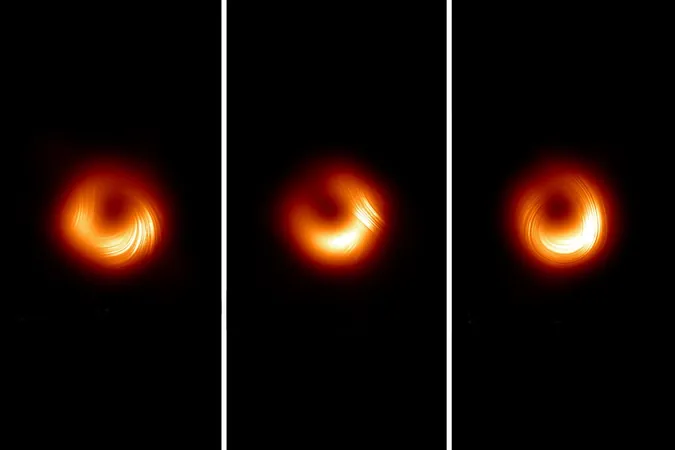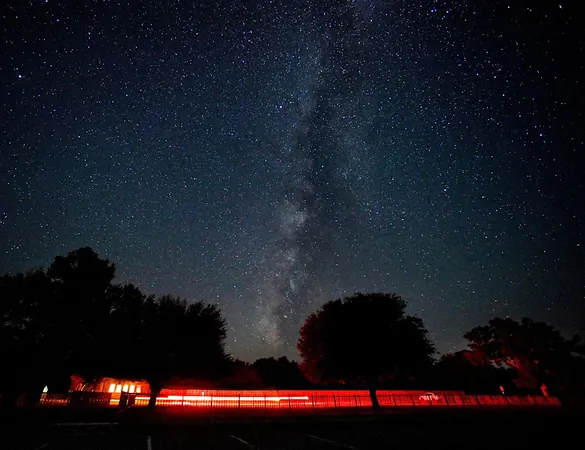
Revolutionary Discoveries: M87's Supermassive Black Hole Unveils Secrets of Magnetic Fields and Particle Jets!
2025-09-18
Author: Benjamin
Groundbreaking Discoveries from the Event Horizon Telescope
Scientists have made astonishing breakthroughs in understanding the supermassive black hole at the heart of galaxy M87, thanks to new images from the Event Horizon Telescope (EHT). This global collaboration, featuring top astronomers from the University of Toronto and worldwide institutions, has revealed intriguing magnetic field reversals and signs of energetic particle jets shooting out at nearly the speed of light!
Unlocking the Mysteries of Black Holes
These findings, detailed in the journal Astronomy & Astrophysics, provide a tantalizing glimpse into the chaotic behavior of matter and energy in the extreme conditions surrounding black holes. Since capturing the first iconic image of M87’s black hole shadow in 2019—located approximately 55 million light-years from Earth—researchers have been on a quest to unravel its complex dynamics.
The Dynamics of Polarized Light
In a significant step forward, astronomers began observing polarized light from M87 in 2021. Unlike ordinary light, polarized light vibrates in a specific orientation due to magnetic fields. By comparing observations from 2017, 2018, and 2021, scientists are piecing together the intriguing puzzle of how the black hole's magnetic fields shift over time.
The Visionaries Behind the Observations
Sebastiano von Fellenberg, a postdoctoral researcher at the Canadian Institute for Theoretical Astrophysics, played a pivotal role in calibrating the latest findings. He corrected for atmospheric interference and discrepancies between the telescopes that make up the EHT network. The addition of two new powerful telescopes—Kitt Peak in Arizona and NOEMA in France—has greatly enhanced the clarity and sensitivity of the images, allowing researchers to track the behavior at the base of M87’s relativistic jet.
Unexpected Magnetic Field Reversals!
In a surprising twist, astronomers found that the polarization patterns from M87 flipped directions between 2017 and 2021. Initially spiraling one way in 2017, the patterns reversed entirely just a few years later, indicating a dynamic and turbulent environment influenced by intricate magnetic forces. This revelation could reshape our understanding of how matter interacts with black holes and how energy is expelled into space.
A Jet with Cosmic Influence
M87's jets are not just spectacular cosmic phenomena; they're critical to galaxy evolution, affecting star formation and energy distribution across vast expanses of space. These jets emit energy across the electromagnetic spectrum—from gamma rays to neutrinos—making them a prime target for studying the intricate processes governing black hole behavior.
The Future Looks Bright for Black Hole Research
With excitement building around the enhanced data quality, researchers are eager for future observations that promise even greater resolution. "M87 is so massive that it takes a long time for changes in its accretion flow to manifest," explained Assistant Professor Bart Ripperda. "To truly monitor this black hole, we need to capture its flares over extended periods, creating a cosmic time-lapse that will unveil more secrets!"
A Dynamic Cosmic Enigma
These groundbreaking results shed light on the dynamic environment surrounding M87, pushing the boundaries of our understanding of black holes. Paul Tiede, co-lead of the study, emphasizes, "While the size of the black hole’s shadow remains consistent with Einstein’s predictions, the significant changes in polarization patterns reveal a complex, ever-evolving cosmic landscape. This activity challenges our theoretical models and opens new avenues for exploration."









 Brasil (PT)
Brasil (PT)
 Canada (EN)
Canada (EN)
 Chile (ES)
Chile (ES)
 Česko (CS)
Česko (CS)
 대한민국 (KO)
대한민국 (KO)
 España (ES)
España (ES)
 France (FR)
France (FR)
 Hong Kong (EN)
Hong Kong (EN)
 Italia (IT)
Italia (IT)
 日本 (JA)
日本 (JA)
 Magyarország (HU)
Magyarország (HU)
 Norge (NO)
Norge (NO)
 Polska (PL)
Polska (PL)
 Schweiz (DE)
Schweiz (DE)
 Singapore (EN)
Singapore (EN)
 Sverige (SV)
Sverige (SV)
 Suomi (FI)
Suomi (FI)
 Türkiye (TR)
Türkiye (TR)
 الإمارات العربية المتحدة (AR)
الإمارات العربية المتحدة (AR)